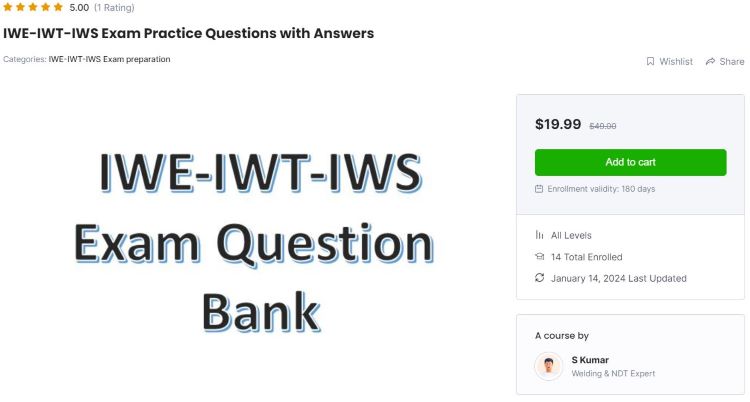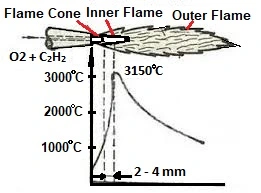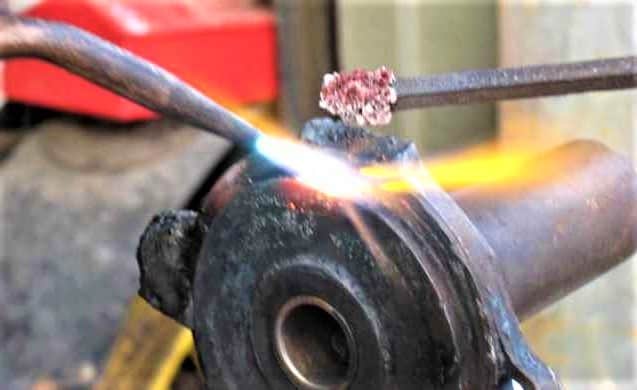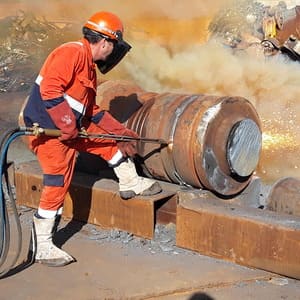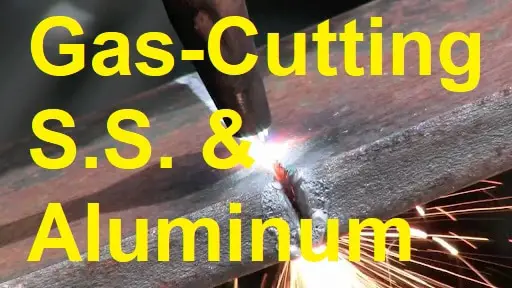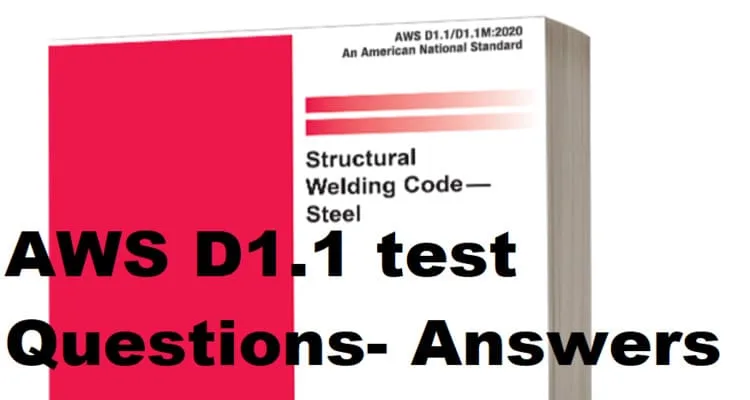Question 1. In Which standard is the term ‘metal Welding’ defined?
- a. EN 14610
- b. EN 1090-2
- c. EN 4711-1
- d. EN 12345
- e. EN 190-1
Question 2. How do you recognize a flame that has acetylene surplus?
- a. The flame is clear and has sharp outlines.
- b. The flame cone is yellowish white.
- c. The flame cone is sharply separated from the external stream.
- d. The flame core is slightly purple.
- e. The mixture ratios of the acetylene and oxygen range from 1 ratio 1 to 1 ratio 2.
Question 3. Which of the following statement is correct concerning welding indexes?
- a. All arc welding processes start with the index 3
- b. All arc welding processes start with the index 1
- c. All gas shielded metal arc welding processes start with the index 13
- d. All submerged arc welding processes start with the index 14.
- e. Both b and c
Question 4. By which letter the resistance welding processes are defined?
- a. R, RA
- b. W, RP
- c. WS
- d. RP
- e. a and d above
Question 5. Which of the following welding processes are part of fusion welding processes?
- a. Gas welding
- b. Friction Welding
- c. Manual arc welding
- d. Hammer welding
- e. a, c and d above
Question 6. The arc is an energy carrier used for the following processes:
- a. TIG welding
- b. Seam Welding
- c. resistance welding
- d. Metal arc welding
- e. Friction stir welding
Question 7. Common example of pressure welding processes are:
- a. Spot welding
- b. Projection welding
- c. Hammer welding
- d. Friction Welding
- e. All of the above
Question 8. Which of the following welding processes are part of the autogenous techniques?
- a. PAW without filler
- b. TIG with tungsten electrode and without filler
- c. Plasma arc spraying
- d. TIG with tungsten electrode and filler
- e. Shielded gas welding
Question 9. Which of the following statements concerning the fuel gas acetylene are correct?
- a. Acetylene is the most used fuel gas in the autogenous techniques.
- b. The molecule acetylene easily falls apart into carbon and oxygen
- c. It is stored in specially equipped cylinders. These cylinders contains a porous filling mass in order to avoid possible falling apart of the gas.
- d. The acetylene regulator back pressure should not exceed 1.5 bar.
- e. a, c and d above
Question 10. Which statement concerning to the fuel gas C2H2 is correct?
- a. It is heavier than the air.
- b. The fuel gas has the lowest combustion temperature of all fuel gases.
- c. This fuel gas has the highest combustion temperature of all fuel gases.
- d. The combustion is affected by a high concentration area.
- e. both a and d
Question 11. How are the movement and working processes of fully mechanized TIG welding and gas shielded metal arc welding defined?
- a. Mechanical manipulation of the torch
- b. Manual manipulation of the torch
- c. Manual filler metal feed and movement
- d. Mechanical filler metal feed
- e. automatic handling of the equipment’s
Question 12. Which of the following statements concerning serial connection of different resistances are correct?
- a. At all resistance there is same voltage difference.
- b. The current is equal in all three resistance.
- c. The current is not equal in all three resistance.
- d. The total resistance is the sum of all single resistance.
- e. The total resistance is smaller than the smallest single resistance.
Question 13. Which of the following formula to calculate the electric power is correct?
- a. P = U2 x I2
- b. P = U divide by I2
- c. P = U2 multiply by I
- d. P = U multiply by I
- e. P = U divide by I
Question 14. Which of the following statements regarding electromagnetism is correct?
- a. Only conductors made of ferromagnetic materials are suitable for making a electromagnet.
- b. There is an electric field only around a conductor where a direct current flows through.
- c. There is an electric field only around a conductor where alternating current flows through.
- d. Attracting forces are effective between parallel conductors with the same direction of current.
- e. Electromagnets work with both alternating current and direct current.
Question 15. The cellulose type electrode (EXX10) are beneficial for
- a. Vertical downhill welding
- b. Thick plate fill pass
- c. Welding of sheet metal
- d. Welding of root runs in pipeline welding
- e. Both a and d
Question 16. Gas shielded metal arc welding is divided into
- a. MAG and FCAW
- b. TIG and MAG
- c. MAG-C and MAG-M
- d. MIG and MAG
- e. Both c and d
Question 17. Which of the following statements regarding welding arc is correct?
- a. The arc cannot be ignited without any contact.
- b. The arc can only be ignited contactless with ignition device.
- c. Arc welding can only be performed with direct current.
- d. Arc welding can only be performed with alternating current.
- e. Arc welding can be performed with direct and alternating current.
Question 18. Which mechanism creates charged particles in the arc?
- a. Shock emission.
- b. Magnet emission
- c. Stray emission
- d. Field emission, Shock ionisation
- e. Thermal emission/ ionisation
Question 19. Personal Protective welding equipments consists of?
- a. Flame resistant clothes
- b. Water resistant clothes
- c. Gloves, safety shoe
- d. Apron to protect from sun heat
- e. Fire blanket
Question 20. Which of the following are the parts of the welding arc?
- a. Anode and cathode fall area
- b. Arc column, arc plasma
- c. Short arc
- d. Pulsed arc
- e. Arc circuit
Question 21. What is called pinch effect in the welding arc?
- a. A drop detachment of the wire electrode in GMAW.
- b. The heating up of the tungsten electrode when TIG welding
- c. Constriction of the free and liquid wire end
- d. Ripping apart the oxide skin when aluminum welding
- e. The different metal transfer mode in SMAW depending upon welding parameters.
Question 22. The charged particle in the arc are created by:
- a. Mechanical friction
- b. Welding current and voltage
- c. Dissociation followed by Ionisation of molecules
- d. Depend upon the shielding gas
- e. Both c and d
Question 23. Which of the following are the tasks of shielding gas in Tungsten inert gas welding?
- a. Increase the weld speed
- b. Cooling the welding torch
- c. Protect the electrode and the welding pool from oxidation
- d. Creation of charged particles in the welding arc
- e. b, c and d above
Question 24. Which statements are correct related to welding arc?
- a. It is created by the shielding gases
- b. It is created by the welding voltage
- c. It consists of plasma
- d. It acts like an ohm resistance
- e. Both c and d
Question 25. Which statement is correct regarding the arc length variation during welding?
- a. Rise in voltage gives rise in arc length
- b. Rise in current gives rise in arc length
- c. Voltage decrease, increase the arc length
- d. Current increase, lower the arc length
- e. Both a and d
Question 26. What is the criteria for the selection of the welding processes?
- a. Geometry of the production area
- b. Geometry of the office area
- c. Qualification of the welding inspector
- d. Economic efficiency of the welding process
- e. Accessibility of the welding seam
Question 27. When using the SAW hotwire process, the advantage over the conventional submerged arc welding ?
- a. Increase the travel speed
- b. Reduce the travel speed
- c. Increase the deposition rate
- d. Decrease the deposition rate
- e. Both a and c
Question 28. Which are the internal defects in submerged arc welding?
- a. Root side suck back
- b. Porosity not open to surface
- c. Lack of fusion
- d. Both c and e
- e. Lamellar tearing
Question29. The purposes of SAW flux during welding are
- a. To avoid the extreme formation of the slag
- b. Allow fast cooling of the weld
- c. Used to shield the hot molten pool
- d. Serve to increase the electric conductivity of the arc gap
- e. Both c and d
Question 30. Submerged arc welding is a
- a. Manual process
- b. Semi-automatic process
- c. Mechanized process
- d. Robotic process
- e. Both b and c
Question 31. Which electrode coating produce highest weld metal toughness in a welding joint when used in shielded metal arc welding process?
- a. Cellulose types
- b. Rutile types
- c. basic types
- d. Acidic rutile type
- e. Both c and d
Question 32. A flux cored wire can be defined as:
- a. A welding electrode produced by wrapping of thin sheet
- b. An endless, inverted stick electrode appearance
- c. A metal filled welding filler wire
- d. A hollow pipe filled with powder for welding in gas metal arc welding
- e. None of the above.
Question 33. When comparing MIG- MAG welding to TIG, the major differences are
- a. Types of the shielding gas
- b. Types of welding filler wire
- c. Weld deposition rate
- d. Types of welding power source
- e. Both c and d
Question 34. What should be the included angle for 10 mm thickness steel plate V groove joint?
- a. 15 to 30 Degree
- b. 40 to 60 degree
- c. minimum 70 degree
- d. Square butt joint is suitable for 10 mm thickness
- e. 30 degree with a root gap of 2.5 mm
Question 35. How the arc length influences the weld geometry?
- a. A too long arc length will produce undercut.
- b. The arc length has no effect on the weld geometry.
- c. The weld width increases with increasing arc length.
- d. The weld width will decrease with increasing arc length
- e. Both a and c
Question 36. Spray arc in gas metal arc welding is beneficial for?
- a. Welding the fill passes in thick plates
- b. Welding open root run in groove welds
- c. Welding sheet metal jobs
- d. Only for fillet welds
- e. Both b & c
Question 37. Which of the following are the related terms for pulse metal transfer?
- a. background current
- b. peak current
- c. Pulse duration
- d. Background duration
- e. All of the above
Question 38. For welding the carbon steel and low alloy steel, the following shielding gas are the best preference:
- a. Gas mixture of M3 group
- b. Gas mixture of M2 group
- c. Pure argon gas
- d. Pure CO2
- e. Mixture of argon with high amount of CO2
Question 39. The advantages of the pulse welding are as follows:
- a. High productivity
- b. Low heat input
- c. Suitable for welding thick plates
- d. Low spatters in welding operation with reduced distortion
- e. Both b and d above
Question 40. Autogenous TIG welding process refer to following operation:
- a. TIG welding without the addition of filler wire
- b. TIG welding without the addition of tungsten electrode
- c. TIG welding with filler wire
- d. GTAW welding without the addition of filler wire
- e. Both a and d
Question 41. Helium in TIG welding gives advantages of:
- a. A higher welding speeds
- b. Lower preheat temperature
- c. Deep penetration
- d. A high welding voltage
- e. All of the above
Question 42. Increasing the content of active gas (such as C O2) in MAG welding will:
- a. Help in reducing the welding spatters
- b. Increase the alloy burnout
- c. The spatters increase
- d. Results in lower mechanical characteristics
- e. Both c and d
Question 43. Which of the following can be used as shielding gases in inert gas welding?
- a. Argon, helium and CO2
- b. Argon, hydrogen
- c. Argon, helium and neon
- d. CO2 and argon mixture, argon and nitrogen mixture
- e. natural gas
Question 44. TIG welding process belongs to the types of welding processes with:
- a. Non-depositing electrode
- b. Depositing electrode
- c. Active shielding gas welding
- d. mechanized welding
- e. Both a and d
Question 45. The arc creates:
- a. The necessary energy for the welding processes
- b. Ultraviolet & infrared radiation
- c. Harmful x-rays
- d. Rays in the dark area
- e. Rays in the ultrablue area.
Question 46. An active shielding gas or its mixture are widely used for welding of carbon steel and low alloy steels when using GMAW. Which of the following statement is correct in this contrast:
- a. Active shielding gas such as C O2 increase the productivity
- b. Carbon steel and low alloy steel do not oxidize rapidly
- c. Active gas for shielding are economical
- d. Active gas are not used for welding of carbon base steels
- e. Both a and c above
Question 47. Gas metal arc welding processes use power sources which are having:
- a. A Flat characteristic
- b. A constant voltage characteristics
- c. A Dropping characteristic
- d. A constant current
- e. Both a and b above.
Question 48. Which of the following gases or their mixture are inert in nature:
- a. Argon-CO2
- b. Argon-O2
- c. Argon-Helium
- d. Argon-Helium-CO2
- e. Both b and c above
Question 49. Electrogas (EGW) welding for carbon steel resembles electroslag welding but the principles is based on:
- a. SAW
- b. ESW
- c. GMAW
- d. GTAW
- e. None of the above
Question 50. What’s the main reason why oxy fuel gas cutting cannot cut stainless steel?
- a. Higher melting point.
- b. Refractory oxides.
- c. Low thermal conductivity.
- d. It can be cut successfully.
- e. Both a and c
Question 51. Which SMAW/MMAW electrode would give the highest recovery rate?
- a. Iron powder.
- b. Rutile.
- c. Cellulose.
- d. Basic.
- e. Both b and d
Question 52. What is the purpose of a rectifier on welding equipment?
- a. Changes AC to DC.
- b. Steps up amperage, steps down voltage.
- c. Steps up voltage and steps down amperage.
- d. All of the above.
- e. Both a and b
Question 53. When performing shielded metal arc welding, which welding electrode would give the highest hydrogen content in the final weld deposit?
- a Rutile.
- b Iron powder
- c Basic.
- d Cellulose
- e. Both a and d
Question 54. Which are the typical range for spray transfer to take place in gas metal arc welding?
- a. 21Volt 200Ampere.
- b. 26 Volt 230 Ampere.
- c. 24 Volt 190 Ampere.
- d. 20 Volt 150 Ampere.
- e. 15 Volt 160 Ampere.
Question 55. In MIG/MAG welding, if stick out length was increased what would be the affect?
- a. Voltage would increase.
- b. Amperage would increase.
- c. Amperage would decrease.
- d. Voltage would decrease.
- e. Both a and c above
Question 56. A high frequency (HF) device in gas tungsten arc welding or TIG welding support the?
- a. Arc striking without electrode contact.
- b. Pulses the welding current.
- c. Smoothes the welding current.
- d. Increase tungsten life.
- e. Increase electrode melt off rate.
Question 57. What is the purpose of an A.C. balance control function?
- a. Gives good arc stability.
- b. Allows greater control over amperage.
- c. Gives control over penetration.
- d. Allows switching from DC to AC.
- e. None of the above
Question 58. The pure tungsten electrodes which works as non-consumable in TIG welding are not used extensively?
- a. Too expensive.
- b. They melt at high temperatures.
- c. They have an unstable arc.
- d. Difficult to prepare.
- e. Pure tungsten not used in TIG welding.
Question 59. The term CPS means?
- a. Current positive system.
- b. Cycles per second.
- c. Cycles positive sometimes.
- d. Current permanently smooth.
- e. Current per second
Question 60. In brazing when comparing to soldering process, the melting point of the filler material is?
- a Above that of the parent material.
- b Below 450ºCelcius.
- c Above 450ºCelcius.
- d About the same as the material.
- e. Above 750 ºCelsius
